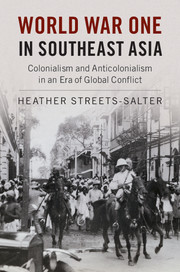Book contents
- Frontmatter
- Dedication
- Contents
- Acknowledgments
- List of Maps
- Maps
- Introduction
- 1 The Singapore Mutiny of 1915: Global Origins in a Global War
- 2 The Defeat of the Singapore Mutiny: Regional Expression of Global Alliances
- 3 Germans, Indians, and the War in the Dutch East Indies
- 4 The S.S. Maverick and the Unraveling of a Global Conspiracy
- 5 Siam and the Anti-Allied Conspiracies
- 6 China, Germany, and the Viet Nam Restoration Association
- Conclusion
- Select Bibliography
- Index
6 - China, Germany, and the Viet Nam Restoration Association
Published online by Cambridge University Press: 06 April 2017
- Frontmatter
- Dedication
- Contents
- Acknowledgments
- List of Maps
- Maps
- Introduction
- 1 The Singapore Mutiny of 1915: Global Origins in a Global War
- 2 The Defeat of the Singapore Mutiny: Regional Expression of Global Alliances
- 3 Germans, Indians, and the War in the Dutch East Indies
- 4 The S.S. Maverick and the Unraveling of a Global Conspiracy
- 5 Siam and the Anti-Allied Conspiracies
- 6 China, Germany, and the Viet Nam Restoration Association
- Conclusion
- Select Bibliography
- Index
Summary
On December 14, 1914, a British detective with the Hong Kong police arrested a Vietnamese man who was staying at a local boarding house. Initially the man pretended to be Chinese, but once detained he confessed his real identity to be none other than Luong Lap Nam – a well-known protégé of the Vietnamese revolutionary Phan Bội Châu and an integral member of Phan's Quang Phuc Hoi, or Viet Nam Restoration Association. The detective took a statement from Luong, in which the latter admitted “I am a revolutionary Annamite: all true Annamites are anxious to liberate their country from French domination.” He justified his revolutionary orientation with a long list of grievances, including French restrictions on indigenous education and travel, French policies requiring the consumption of opium and alcohol, and the inability of indigenous soldiers to rise to high rank. Luong insisted that each country should be governed by its own subjects and compared his revolutionary struggle with the successful Chinese struggle against the Manchu and the ongoing South African and Indian struggles against the British. He ended by insisting that he had broken no laws in Hong Kong and asked that he be set free so that he could proceed to his intended destination in Kwangtung (Guangdong).
But British authorities did not release Luong. Instead, on January 14 they secretly transferred him to Gaston Liébert, the French consul in Hong Kong, who had him whisked away on a ship under heavy guard. Two secret agents accompanied Luong from Hong Kong to the French enclave of Kuongtcheouwan (Guongzhouwan), where French authorities formally arrested him. From there, he was taken to Hanoi in French Indochina, where he was tried for his role in a 1913 bombing in the northern province of Phu Tho. Luong was convicted and sentenced to life with hard labor, and was finally transferred to the notorious Thai Nguyen prison in July 1916. At the prison, he was considered so dangerous that he was kept shackled in solitary confinement. Anxieties about the threat he posed proved accurate, because a little more than a year later Luong played a critical role in the Thai Nguyen rebellion centered on the prison – the most significant rebellion in Indochina between 1880 and 1930 – and was killed by French forces on September 4, 1917.
- Type
- Chapter
- Information
- World War One in Southeast AsiaColonialism and Anticolonialism in an Era of Global Conflict, pp. 169 - 213Publisher: Cambridge University PressPrint publication year: 2017



